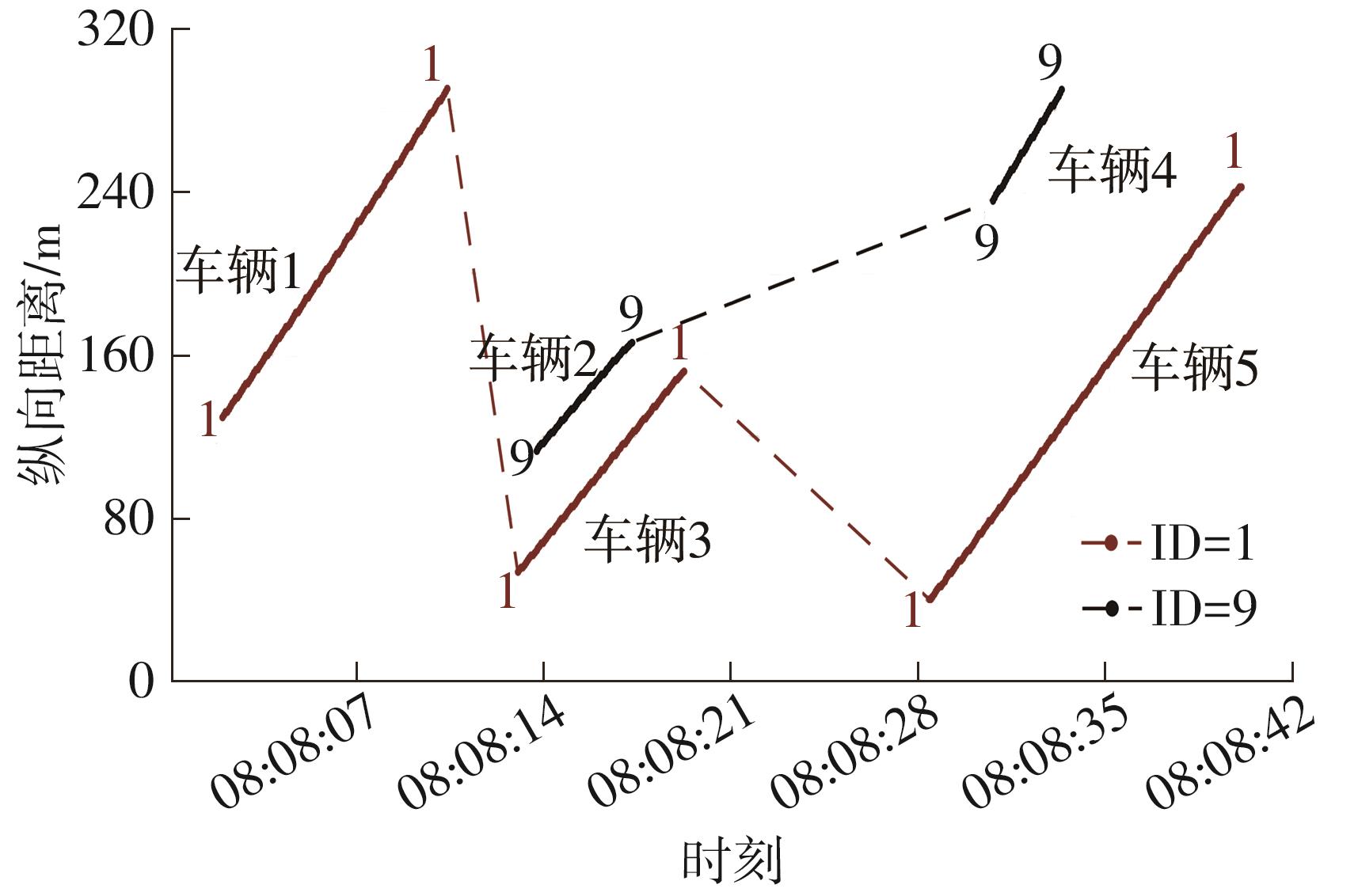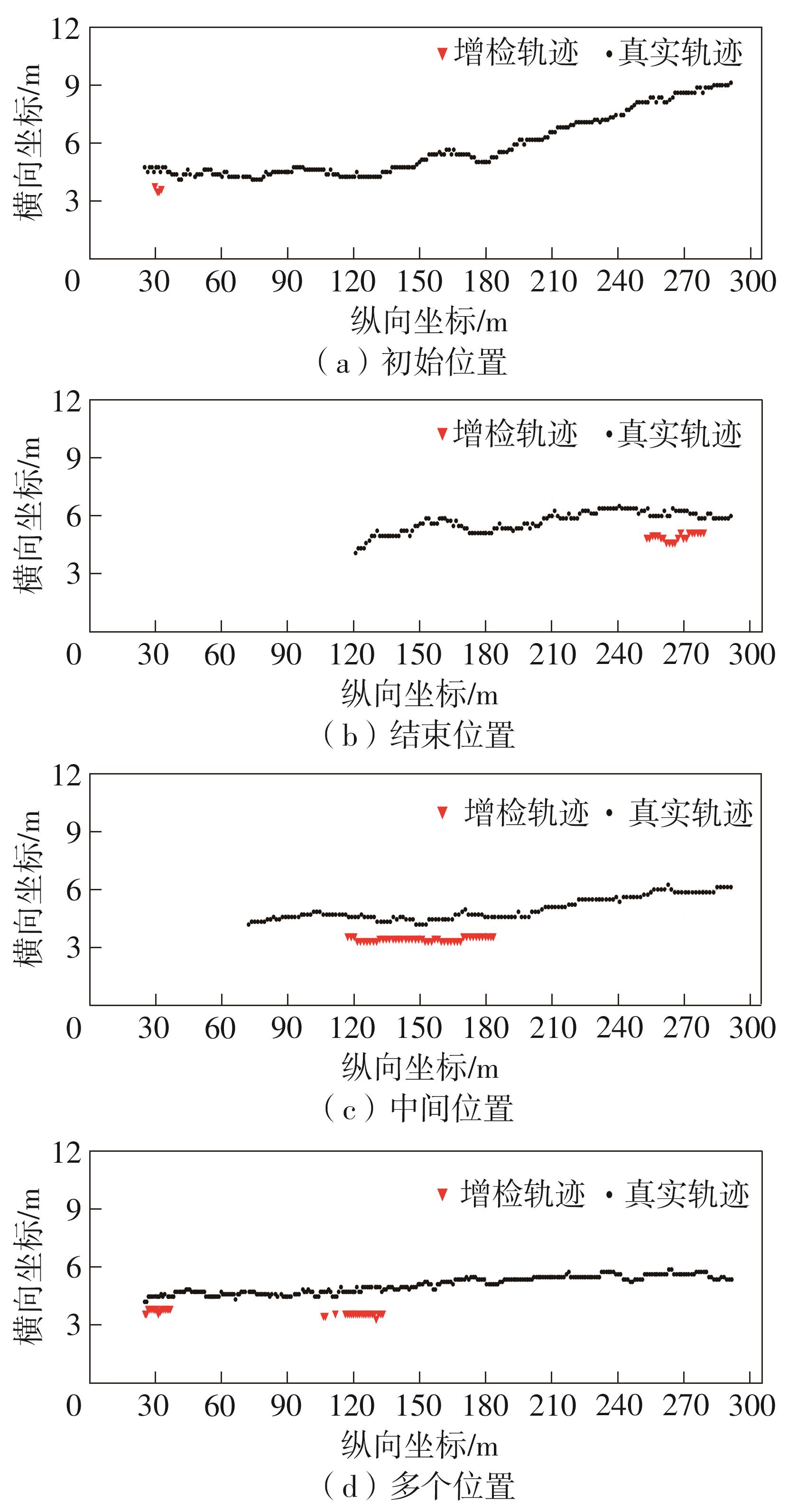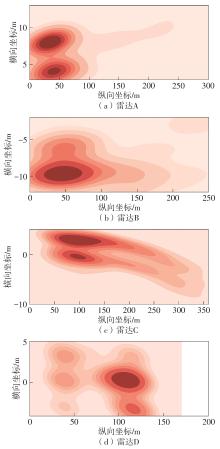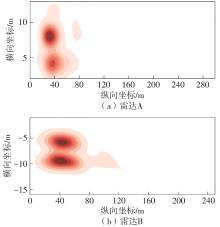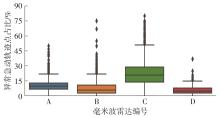华南理工大学学报(自然科学版) ›› 2024, Vol. 52 ›› Issue (6): 56-72.doi: 10.12141/j.issn.1000-565X.230314
路侧感知车辆轨迹数据的质量评估方法
雷财林1( ), 赵聪1, 娄刃2, 暨育雄1†(
), 赵聪1, 娄刃2, 暨育雄1†( ), 杜豫川1
), 杜豫川1
- 1.同济大学 道路与交通工程教育部重点实验室, 上海 201804
2.浙江省交通运输科学研究院 新一代人工智能技术交通运输行业研发中心, 浙江 杭州 310023
-
收稿日期:2023-05-10出版日期:2024-06-25发布日期:2023-10-27 -
通信作者:暨育雄(1978—),男,博士,教授,博士生导师,主要从事自动驾驶可信评价、交通数据挖掘与智能决策研究。 E-mail:yxji@tongji.edu.cn -
作者简介:雷财林(1992—),男,博士生,主要从事轨迹数据处理、驾驶行为建模研究。E-mail: 2010762@tongji.edu.cn -
基金资助:国家重点研发计划项目(2022YFF0604900);国家自然科学基金资助项目(52302415)
Quality Assessment Method of Vehicle Trajectory Data from Roadside Perception
LEI Cailin1( ), ZHAO Cong1, LOU Ren2, JI Yuxiong1(
), ZHAO Cong1, LOU Ren2, JI Yuxiong1( ), DU Yuchuan1
), DU Yuchuan1
- 1.Key Laboratory of Road and Traffic Engineering of the Ministry of Education,Tongji University,Shanghai 201804,China
2.Research and Development Center of Transport Industry of New Generation of Artificial Intelligence Technology,Zhejiang Scientific Research Institute of Transport,Hangzhou 310023,Zhejiang,China
-
Received:2023-05-10Online:2024-06-25Published:2023-10-27 -
Contact:暨育雄(1978—),男,博士,教授,博士生导师,主要从事自动驾驶可信评价、交通数据挖掘与智能决策研究。 E-mail:yxji@tongji.edu.cn -
About author:雷财林(1992—),男,博士生,主要从事轨迹数据处理、驾驶行为建模研究。E-mail: 2010762@tongji.edu.cn -
Supported by:the National Key Research and Development Program of China(2022YFF0604900);the National Natural Science Foundation of China(52302415)
摘要:
路侧传感器已大量部署在高速公路上,用来实时采集路段全样本车辆轨迹数据,为交通流全时空管控、微观驾驶行为分析等提供数据支持,但数据质量的快速评估一直是困扰行业管理部门的难题。现有的车辆轨迹数据评估方法大多存在操作复杂、维度单一等问题,难以满足对动态交通流中实时产生的车辆轨迹数据的评价需求。为快速判别路侧毫米波雷达车辆轨迹数据的质量,文中通过挖掘数据自身信息提出了一种数据质量评价方法。首先,在分析实测轨迹数据典型问题的基础上,从轨迹完整性、一致性、准确性及有效性4个维度建立了9个二级评价指标;然后,基于CRITIC赋权法计算综合指标;最后,针对4种不同场景的3 549条毫米波雷达实测轨迹进行了实证分析。结果表明,毫米波雷达的安装方式、型号等会显著影响车辆轨迹数据的质量,所提出的数据质量评价方法能够量化不同车辆轨迹数据的质量差异。文中研究结果可为路侧传感器采集数据性能衰变的短时监测及数据采集设备的选型提供支持,也可为车辆轨迹数据质量的提升提供方法参考。
中图分类号:
引用本文
雷财林, 赵聪, 娄刃, 暨育雄, 杜豫川. 路侧感知车辆轨迹数据的质量评估方法[J]. 华南理工大学学报(自然科学版), 2024, 52(6): 56-72.
LEI Cailin, ZHAO Cong, LOU Ren, JI Yuxiong, DU Yuchuan. Quality Assessment Method of Vehicle Trajectory Data from Roadside Perception[J]. Journal of South China University of Technology(Natural Science Edition), 2024, 52(6): 56-72.
表7
评价指标影响因素及可能被影响的应用"
| 评价维度 | 评价指标 | 影响因素 | 可能被影响的应用 |
|---|---|---|---|
| 完整性 | 轨迹完整度 | 物理遮挡,设备识别及跟踪目标的能力 | 交通流管控,驾驶行为分析 |
| 一致性 | 流量一致度 | 物理遮挡,设备识别及跟踪目标的能力 | 交通流管控,交通状态识别 |
| 车辆ID一致度 | 物理遮挡,设备识别及跟踪目标的能力 | 驾驶行为分析,车路协同 | |
| 车型一致度 | 物理遮挡,设备识别目标的能力 | 交通流管控,驾驶行为分析 | |
| 准确性 | 纵向定位漂移率 | 设备定位目标的能力 | 驾驶行为分析,车路协同 |
| 回传时间稳定度 | 设备记录数据的时效及稳定性 | 驾驶行为分析,车路协同 | |
| 有效性 | “假倒车”率 | 设备定位目标的能力 | 驾驶行为分析,车路协同 |
| 异常急动率 | 设备检测速度及记录数据的时效、稳定性 | 驾驶行为分析,车路协同 | |
| 交通事故误报率 | 设备定位目标的能力 | 驾驶行为分析,车路协同 |
| 1 | PATRON-PEREZ A, LOVEGROVE S, SIBLEY G .A spline-based trajectory representation for sensor fusion and rolling shutter cameras[J].International Journal of Computer Vision,2015,113(3):208-219. |
| 2 | ZHAO T, XU Y, MONFORT M,et al .Multi-agent tensor fusion for contextual trajectory prediction[C]∥Proceedings of the IEEE/CVF Conference on Computer Vision and Pattern Recognition.[S. l.]:[s. n.],2019:12126-12134. |
| 3 | LEI C, ZHAO C, JI Y,et al .Identifying and correcting the errors of vehicle trajectories from roadside millimetre‐wave radars[J].IET Intelligent Transport Systems,2023,17(2):418-434. |
| 4 | CHEN Z, WU C, HUANG Z,et al .Dangerous driving behavior detection using video-extracted vehicle trajectory histograms[J].Journal of Intelligent Transportation Systems,2017,21(5):409-421. |
| 5 | YU R, HAN L, ZHANG H .Trajectory data based freeway high-risk events prediction and its influencing factors analyses[J].Accident Analysis & Prevention,2021,154:106085/1-10. |
| 6 | 杜豫川,都州扬,师钰鹏,等 .路侧感知车辆轨迹数据质量智能评估方法[J].中国公路学报,2021,34(7):164-176. |
| DU Yu-chuan, DU Zhou-yang, SHI Yu-peng,et al .Intelligent evaluation method for roadside sensing vehicle trajectory data quality[J].Chinese Journal of Highways,2021,34(7):164-176. | |
| 7 | ROCHA T V DA, LECLERCQ L, MONTANINO M,et al .Does traffic-related calibration of car-following models provide accurate estimations of vehicle emissions?[J].Transportation Research Part D:Transport and Environment,2015,34:267-280. |
| 8 | SHARMA A, ZHENG Z, BHASKAR A .A pattern recognition algorithm for assessing trajectory completeness[J].Transportation Research Part C:Emerging Technologies,2018,96:432-457. |
| 9 | KESTING A, TREIBER M .Calibrating car-following models by using trajectory data:methodological study[J].Transportation Research Record,2008,2088(1):148-156. |
| 10 | SADEQ H, SAYED T .Automated roundabout safety analysis:diagnosis and remedy of safety problems[J].Journal of Transportation Engineering,2016,142(12):04016062/1-8. |
| 11 | TAGELDIN A, SAYED T, ISMAIL K .Evaluating the safety and operational impacts of left-turn bay extension at signalized intersections using automated video analysis[J].Accident Analysis & Prevention,2018,120:13-27. |
| 12 | JI Y, NI L, ZHAO C,et al .TriPField: a 3D potential field model and its applications to local path planning of autonomous vehicles[J].IEEE Transactions on Intelligent Transportation Systems,2023,24(3):3541-3554. |
| 13 | ZHAO C, SONG A, ZHU Y,et al .Data-driven indoor positioning correction for infrastructure-enabled autonomous driving systems: a lifelong framework[J].IEEE Transactions on Intelligent Transportation Systems,2023,24(4):3908-3921. |
| 14 | FARAH H, DAAMEN W, HOOGENDOORN S .How do drivers negotiate horizontal ramp curves in system interchanges in the Netherlands?[J].Safety Science,2019,119:58-69. |
| 15 | BEINUM A, FARAH H, WEGMAN F,et al .Driving behaviour at motorway ramps and weaving segments based on empirical trajectory data[J].Transportation Research Part C:Emerging Technologies,2018,92:426-441. |
| 16 | WANG C, XU C, DAI Y .A crash prediction method based on bivariate extreme value theory and video-based vehicle trajectory data[J].Accident Analysis & Prevention,2019,123:365-373. |
| 17 | GU X, ABDEL-ATY M, XIANG Q,et al .Utilizing UAV video data for in-depth analysis of drivers’ crash risk at interchange merging areas[J].Accident Analysis & Prevention,2019,123:159-169. |
| 18 | ZHANG L Y, PENG Z R, SUN D J,et al .A UAV-based automatic traffic incident detection system for low volume roads[R].[S. l.]:[s. n.],2013. |
| 19 | COIFMAN B, MCCORD M, MISHALANI R G,et al .Roadway traffic monitoring from an unmanned aerial vehicle[J].IEE Proceedings - Intelligent Transport Systems,2006,153(1):11-20. |
| 20 | JIN P J, ARDESTANI S M, WANG Y,et al .Unmanned aerial vehicle (UAV) based traffic monitoring and management[R].New Jersey:Center for Advanced Infrastructure and Transportation of Rutgers University,2016. |
| 21 | MA W, HE Z, WANG L,et al .Active traffic management strategies for expressways based on crash risk prediction of moving vehicle groups[J].Accident Analysis & Prevention,2021,163:106421/1-12. |
| 22 | PUNZO V, BORZACCHIELLO M T, CIUFFO B .On the assessment of vehicle trajectory data accuracy and application to the Next Generation SIMulation (NGSIM) program data[J].Transportation Research Part C:Emerging Technologies,2011,19(6):1243-1262. |
| 23 | COIFMAN B, LI L .A critical evaluation of the Next Generation Simulation (NGSIM) vehicle trajectory dataset[J].Transportation Research Part B:Metho-dological,2017,105:362-377. |
| 24 | WANG Z, LU M, YUAN X,et al .Visual traffic jam analysis based on trajectory data[J].IEEE Transactions on Visualization and Computer Graphics,2013,19(12):2159-2168. |
| 25 | ZWAHLEN H T, RUSS A, ONER E,et al .Evaluation of microwave radar trailers for nonintrusive traffic measurements[J].Transportation Research Record,2005,1917(1):127-140. |
| 26 | KIM S, COIFMAN B .Assessing the performance of SpeedInfo radar traffic sensors[J].Journal of Intelligent Transportation Systems,2017,21(3):179-189. |
| 27 | 王宝锋 .基于机器学习与传感器融合的车辆与车道线识别研究[D].北京:北京理工大学,2017. |
| 28 | HU H .Measuring the effectiveness of advanced traveler information systems (ATIS)[D].Raleigh:North Carolina State University,2008. |
| 29 | 杜豫川,师钰鹏,都州扬,等 .智能网联环境下路侧感知单元数据质量在线监测框架[J].中国公路学报,2022,35(3):273-285. |
| DU Yu-chuan, SHI Yu-peng, DU Zhou-yang,et al .A framework for online monitoring of data quality of roadside sensing units in an intelligent networked environment[J].Chinese Journal of Highways,2022,35(3):273-285. | |
| 30 | 林宇 .基于 GNSS 的异常定位序列挖掘方法研究[D].长春:吉林大学,2020. |
| 31 | LI Z, LI X, LIU S,et al .A study on trajectory planning of hydraulic robotic excavator based on movement stability[C]∥Proceedings of 2016 13th International Conference on Ubiquitous Robots and Ambient Intelligence (URAI).[S. l.]:IEEE,2016:582-586. |
| 32 | YANG C, GIDÓFALVI G .Trajectory quality assessment based on movement feature stability[C]∥Proceedings of the International Symposium on Location-Based Big Data.Tokyo:[s. n.],2019. |
| 33 | 王风伟 .车辆轨迹数据质量评价方法研究[D].哈尔滨:哈尔滨工业大学,2017. |
| 34 | MEINEL H H .Applications of microwaves and millimeter waves for vehicle communications and control in Europe[C]∥Proceedcings of 1992 IEEE MTT-S Microwave Symposium Digest.[S.l.]:IEEE,1992:609-612. |
| 35 | 施莉娟,朱健,陈小鸿,等 .基础交通数据质量评价研究[J].交通信息与安全,2011,29(5):57-61. |
| SHI Lijuan, ZHU Jian, CHEN Xiaohong,et al .Study on the quality evaluation of basic traffic data[J].Traffic Information and Safety,2011,29(5):57-61. | |
| 36 | LIU P, YU G, WANG Z,et al .Object classification based on enhanced evidence theory:radar-vision fusion approach for roadside application[J].IEEE Transactions on Instrumentation and Measurement,2022,71:1-12. |
| 37 | DU L P, SU G C .new method for target detection of MMW radar[C]∥Proceedings of the 7th International Conference on Signal Processing,2004.[S. l.]:IEEE,2004:2029-2032. |
| 38 | DIAKOULAKI D, MAVROTAS G, PAPAYANNAKIS L .Determining objective weights in multiple criteria problems:the critic method[J].Computers & Operations Research,1995,22(7):763-770. |
| 39 | CAI X, LEI C, PENG B,et al .Road traffic safety risk estimation method based on vehicle onboard diagnostic data[J].Journal of Advanced Transportation,2020,2020:1-13. |
| 40 | ZHAO C, SONG A, DU Y,et al .TrajGAT:a map-embedded graph attention network for real-time vehicle trajectory imputation of roadside perception[J].Transportation Research Part C:Emerging Technologies,2022,142:103787/1-23. |
| 41 | DU Y, QIN B, ZHAO C,et al .A novel spatio-temporal synchronization method of roadside asynchronous MMW radar-camera for sensor fusion[J].IEEE transactions on Intelligent Transportation Systems,2021,23(11):22278-22289. |
| [1] | 张云超, 黄建玲, 李永行, 等. 考虑换道博弈的驾驶风格在线识别方法[J]. 华南理工大学学报(自然科学版), 2024, 52(4): 126-137. |
| [2] | 卢凯 林茂伟 邓兴栋 徐广辉 徐建闽. 停车总成本最小的区域停车位动态分配与诱导模型[J]. 华南理工大学学报(自然科学版), 2018, 46(9): 82-91,98. |
| [3] | 骆晨 刘澜. 交通诱导信息组合方式对路径决策的影响[J]. 华南理工大学学报(自然科学版), 2017, 45(8): 77-83. |
| [4] | 王泽胜 董宝田 王爱丽. 基于自适应脉冲耦合神经网络的行人检测方法[J]. 华南理工大学学报(自然科学版), 2017, 45(6): 74-80. |
| [5] | 秦华标 肖志勇. 基于位置信息的稳定分簇路由协议[J]. 华南理工大学学报(自然科学版), 2010, 38(6): 1-6. |
| [6] | 温惠英 徐建闽 邹亮 . 基于遗传算法的离散时间动态网络最短路径求解[J]. 华南理工大学学报(自然科学版), 2008, 36(2): 13-16,28. |
| [7] | 黄玲 徐建闽. 基于浮动车技术的动态交通拥挤预测模型[J]. 华南理工大学学报(自然科学版), 2008, 36(10): 47-50,56. |
| [8] | 史胜利 徐建闽 秦钟. 基于CDMA 和GSM 网络的车辆定位方法[J]. 华南理工大学学报(自然科学版), 2007, 35(2): 50-53. |
| [9] | 钟慧玲 徐建闽 彭选荣. 专用短程通信协议模型的求解与分析[J]. 华南理工大学学报(自然科学版), 2005, 33(6): 18-22. |
| [10] | 钟慧玲 徐建闽 彭选荣. 专用短程通信协议模型的建立[J]. 华南理工大学学报(自然科学版), 2005, 33(4): 34-38. |
| [11] | 屠宇 徐建闽 钟慧玲. ITS专用短程通信的协议验证[J]. 华南理工大学学报(自然科学版), 2005, 33(3): 63-68. |
| [12] | 屠宇 徐建闽 钟慧玲. ITS专用短程通信协议一致性测试系统的设计与实现[J]. 华南理工大学学报(自然科学版), 2004, 32(8): 9-12. |
| [13] | 董明望 阮平. 基于Agent技术的供应商管理系统的设计[J]. 华南理工大学学报(自然科学版), 2004, 32(2): 72-75. |
| [14] | 陈伟 丁秋林 谢强. 交互式数据迁移系统及其相似检测效率优化[J]. 华南理工大学学报(自然科学版), 2004, 32(2): 58-61. |
| [15] | 胡郁葱, 徐建闽, 吴一民, 等. 基于BP神经网络的车辆定位融合模型[J]. 华南理工大学学报(自然科学版), 2004, 32(2): 46-49. |
| 阅读次数 | ||||||
|
全文 |
|
|||||
|
摘要 |
|
|||||



